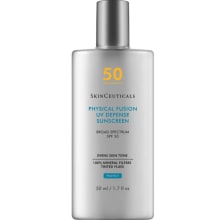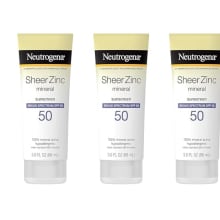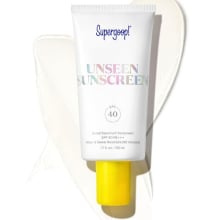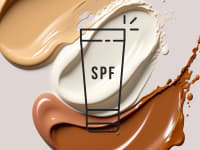A 411 on sunscreen that won't have you channeling "Casper"
Good sun protection doesn't have to be visible
 Credit:
Reviewed
Credit:
Reviewed
Products are chosen independently by our editors. Purchases made through our links may earn us a commission.
Sunscreen should be a non-negotiable for you, not matter the time of year, but especially in warmer months when you’re spending more time outdoors under a much stronger sun.
Apart from choosing an SPF number (hint: higher is better) that suits your skin—from your legs to your face and your scalp), what else do you need to know? Does your head spin from all of the options at your local drugstore or fave online retailer? Worst yet, why does some sunscreen leave you with a ghostly white glow?
So, when it comes to physical and chemical sunscreen: What's the difference? We’ve got some answers.
How does SPF work?
For starters, it’s helpful to know how SPF works and why you should wear it every day.
SPF, or "sun protection factor," relates to the sunscreen’s ability to block UVB light, which is the wavelength responsible for sunburns. The higher the number following “SPF,” the higher percentage of UVB rays are blocked and the longer you can stay in direct sunlight without burning.
To block UVA rays, which are linked to premature aging, you want to look for the phrase “broad spectrum protection” on your sunscreen’s packaging. Both UVA and UVB rays cause damage to DNA cells that can lead to skin cancer.
To achieve SPF, companies use active ingredients that block or reflect away the sun’s damaging rays—referred to as physical sunscreens—or absorb and release their energy without allowing it to penetrate the skin, a.k.a., chemical sunscreens.
Physical and chemical sunscreen: What's the difference?
How do physical sunscreens work?
Physical sunscreens sit on top of the skin and deflect rays to keep them from penetrating the skin’s surface. They’re also called “mineral” sunscreens, as they use zinc oxide and/or titanium dioxide to create a film over the skin to shield the skin from harm. They take effect immediately after application, rather than needing to soak in to achieve their full effect. On the downside, these physical ingredients can also be difficult if not impossible to fully blend in, leaving that telltale white cast on the skin.
The good news is, some companies make “cosmetically elegant” SPF products containing “micronized physical blockers” that won’t cause a ghostly appearance, explains Suzanne Friedler, MD, F.A.A.D, a board-certified dermatologist with Advanced Dermatology PC in New York City.
It’s difficult to tell just from packaging and ingredients if a physical sunscreen will leave a white cast or if it’s “cosmetically elegant,” but you’ll find keywords like “microfine” or “micronized” in product descriptions and these are helpful indicators, and you can also look to testimonials from online user reviews.

Reviewers say this feels lightweight on the skin and looks “invisible.”

For a more budget-friendly option, the goes on pigmented but reviewers say it turns translucent when it’s massaged into the skin. This comes in a 3-pack.
How do chemical sunscreens work?
Another option for avoiding a white cast is to choose a chemical sunscreen. These products contain active ingredients such as avobenzone, octisalate, and oxybenzone, which absorb into the skin and protect it by converting the sun’s UV rays into heat that’s then released into the air.
The ingredients absorb into the skin instead of sitting on top of it the way that physical sunscreens do, so they’re less likely to leave a white cast. However, they typically take about 15 minutes to reach maximum effectiveness, so you must be even more diligent about reapplying so there are no gaps in your skin’s protection.
Chemical sunscreens have also been associated with some controversy regarding what, if any, risks their absorption may pose to human health—for now, the FDA says to continue using sunscreen, as the ramifications of not using it are likely riskier than any harm from absorption of the ingredients.

For a popular chemical sunscreen option, look to this one, which uses avobenzone, homosalate, octisalate, and octocrylene to protect the skin from the sun. Users rave about its smooth finish that layers seamlessly under makeup.
Which type of sunscreen is right for you?
There’s no right or wrong answer, as both sunscreen types have one major benefit, when used correctly: protecting your skin from the damaging effects of the sun.
That said, there are hundreds of sunscreens out there, some that claim to moisturize dry skin and others that claim to keep oil at bay, and those are factors to consider as well. As long as you’ve got your skin covered, you can’t go wrong.


